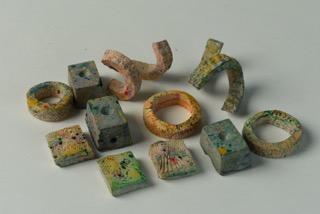Unit X Reflections
Throughout this project I have learned that collaboration can
happen unexpectedly, and doesn’t have to be manifested through swapping samples.
Rather, it can mean sharing ideas, skills, or even just working in the same
environment and problem-solving as a team. Regarding my personal practice, I
have discovered that working with other people has helped me go out of my
comfort zone and take more risks.
I engaged with all aspects of the unit, undertaking
my primary research of photographing architecture around Manchester
individually, then sharing this with the rest of the groups’ research. Over the
Easter break, we didn’t stay in touch consistently, and this led to us feeling
a bit disconnected when we returned about how to develop our ideas into
samples. However, this time apart meant that we had been able to fully research
our individual crafts.
The idea to run workshops was a turning point for us in
terms of the direction of our sampling and our relationship as a group. Instead
of focusing on an idea for a final piece, we concentrated on working
collaboratively. This proved insightful and creatively stimulating, as the more
we learned from each other, the more we could experiment through sampling. This
process of gathering knowledge and then passing it on was beneficial in
encouraging us to take risks and learning not to be precious about our own
work.
 |
| Thinking about our samples as parts of a larger artwork, rather than individual pieces. Each sample showcasing influences of multiple endagered crafts. |
We were then able to use the skills learned to better inform
our own practices. For me the best thing about this process was us all working
in the same space together, even if it was on separate things. This collective
hive of activity inspired me to work harder and experiment more – I became less
concerned about things failing, because I had the support of other people to
work through problems and test solutions.
 |
| Combining skills from ceramics, calligraphy and marbling. |
I think our initial research may have been stronger if we
had conducted it as a group, rather than individually. We all had a different
vision of the theme of architecture at the start, making it difficult for us to
express our ideas and come up with a cohesive plan of how to begin making.
Although I think that having the Easter break apart was a turning point for us
realising that we needed to work together more, if we could do the project
again we would address our initial apprehensions sooner.
Materials were integral to the design process and inherent
to our chosen crafts, from ceramics to yarn, although greater discussion about
the materials we were using could have been beneficial. We thought about
materials in relation to the theme of architecture, for example concrete, and
how this could be combined with yarn, paper, ceramics, calligraphy and marbling
to give them an architectural feel. Overall our exploration of materials was
in-depth but could have been improved by greater group experimentation from the
start to identify issues with combining certain materials, such as the weight
of concrete on paper.
Our main communication was through the workshop sessions.
Learning to think through making was one of the most important lessons I took
away from the process. I experimented with stitching, laser cutting into
Perspex and then marbling onto it, which inspired me to weave on top of it, an
amalgamation of the skills learned through collaboration. However, in embracing this way of working we at times lost sight of our initial theme, and found it difficult to re-adjust our sampling to reflect architectural values, instead honing in on the processes of the endangered crafts. Additional and no less important communication through our WhatsApp group was critical in allowing us to be open and honest with each other about the direction of the project. Having this informal forum for discussion gave everyone an equal voice in the group, so no one person's opinions became overbearing.
 |
| Our final samples and booklet in situ in the exhibition at the Manchester Craft and Design Centre. The architectural heritage of the building provided inspiration for our theme and its industrial appearance is echoed in our choice of materials. |
I’ve spent the last fortnight of the project on placement at Rob Ryan studio in London, where I have mainly been assisting with paper cutting, which has really benefited my understanding of endangered crafts and traditional processes. Despite not being with my group in person, we have kept in contact through WhatsApp and I have been updated with the progress of sampling in anticipation of the upcoming exhibition. This has allowed me to continue to offer suggestions and support my group with finalising the samples and preparing for the deadline.



















Comments
Post a Comment